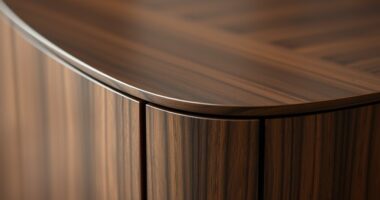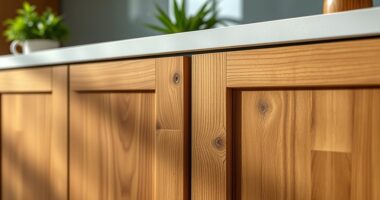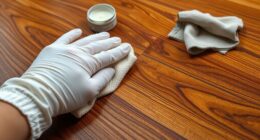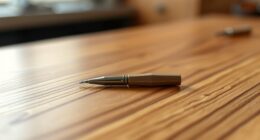Choosing the right joinery for your face frame depends on your needs. Pocket screws are quick, easy, and great for DIY projects, providing a clean look without visible fasteners. Dowel joints offer a traditional, strong, and hidden connection that looks professional. Mortise-and-tenon joints are the most durable, perfect for long-lasting furniture but require more skill and time. Exploring your options further will help you select the best fit for your project.
Key Takeaways
- Pocket screws are ideal for quick, clean face frame assembly, especially in DIY projects.
- Dowel joints offer precise, hidden connections with a traditional, professional appearance.
- Mortise-and-tenon joints provide unmatched strength and durability, suitable for high-end or load-bearing frames.
- Material choice affects joinery suitability; softwoods work well with pocket screws, while hardwoods excel with mortise-and-tenon.
- Consider project scope and desired aesthetics when selecting joinery—quick assembly or maximum strength.
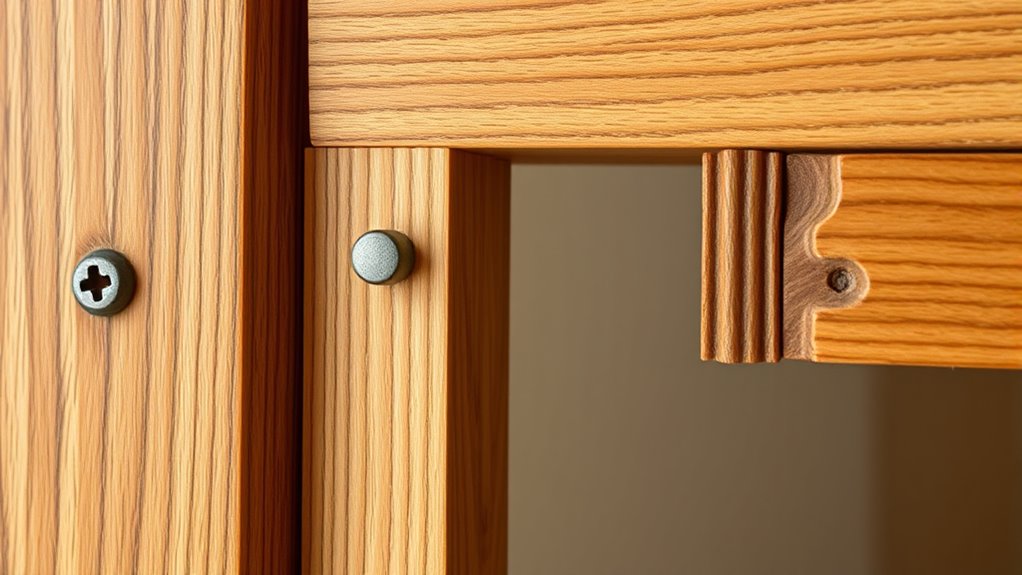
Have you ever wondered how cabinets and furniture get that polished, finished look? The secret lies in the joinery techniques you choose and how carefully you select your materials. When constructing a face frame, your options typically include pocket screws, dowels, or mortise-and-tenon joints. Each method offers distinct advantages, and your decision impacts both the strength and appearance of your project.
Start by considering your joinery techniques. Pocket screws are quick and easy to use, making them popular for DIY projects and cabinet framing. They allow you to join face frames to cabinet boxes efficiently, with the screws hidden on the inside or behind a face. This technique requires minimal clamping and can be completed rapidly, which is ideal if you’re aiming for a clean look without visible fasteners. On the other hand, dowels provide a more traditional approach. Using dowel pins, you create precise, hidden joints that add strength and a professional touch. Dowel joints demand careful alignment, but once mastered, they produce a seamless appearance and increased durability. Mortise-and-tenon joints, however, are the gold standard for strength and longevity. They involve carving a cavity (mortise) into one piece and fitting a projecting tenon from another, creating a joint that withstands tension and shear forces remarkably well. While more time-consuming and requiring advanced skills, mortise-and-tenon joints deliver unmatched stability and a high-end aesthetic. Additionally, understanding different joinery techniques can help you optimize your woodworking and achieve better results.
Material selection plays a vital role in the success of your face frame. Softwoods like pine are easier to work with and cost-effective, making them suitable for beginner projects. Hardwoods such as oak or maple offer superior strength and a refined finish but demand sharper tools and more precise craftsmanship. The choice of material also influences how your joinery techniques perform; for example, pocket screws work well with softer woods, while mortise-and-tenon joints excel with denser hardwoods. Additionally, consider the finish and look you want to achieve. A high-quality hardwood can showcase intricate joinery details, while softer woods might hide some of the finer craftsmanship but still deliver a sturdy, attractive face frame.
Ultimately, your selection of joinery techniques and materials depends on your skill level, budget, and desired outcome. If speed and ease are priorities, pocket screws are a solid choice. For a traditional, robust build, dowels or mortise-and-tenon joints are preferable. Whichever route you take, paying attention to material selection will guarantee your face frame not only looks great but also holds up over time. Combining the right joinery with quality materials allows you to craft furniture that’s both beautiful and durable, with a finished look that truly stands out.
Frequently Asked Questions
Which Face Frame Construction Method Offers the Best Durability?
You’ll find mortise-and-tenon offers the best durability for face frames because it creates a strong edge joint that withstands stress. Proper glue application enhances this strength, ensuring a lasting bond. Unlike pocket screws or dowels, mortise-and-tenon connections provide superior stability, especially in heavy-use furniture. If durability’s your goal, investing in this method helps your face frame hold up over time, even with frequent movement or weight.
Can Different Joinery Techniques Be Combined in One Face Frame?
Mixing joinery techniques in a face frame is like blending colors on a palette—you get greater aesthetic flexibility. You can definitely combine pocket screws, dowels, and mortise-and-tenon joints in one face frame to optimize strength and appearance. This approach allows you to leverage each method’s strengths, creating a more durable and visually appealing piece. Just make certain proper planning so the joints complement each other seamlessly.
How Does Joinery Choice Affect Cabinet Repair or Modification?
Your choice of joinery impacts repair flexibility and ease considerably. Pocket screws are quick and simple to fix, making repairs straightforward, while dowels offer a bit more strength but can be trickier to realign. Mortise-and-tenon joints provide durability but might be more challenging to repair due to their complexity. Selecting joinery that balances your need for repair ease with structural integrity ensures your cabinet stays functional and easy to maintain.
Are There Cost Differences Between Pocket Screws, Dowels, and Mortise-And-Tenon?
Think of joinery as building a house of cards—each method has its own weight. Pocket screws are like lightweight paper, usually cheaper in material costs and quicker to install, saving labor expenses. Dowels are sturdier but cost a bit more in materials and time. Mortise-and-tenon joints are the most robust but also the most expensive due to higher material costs and labor. Your choice influences overall project costs markedly.
Which Joinery Method Is Fastest for DIY Beginners?
If you’re a DIY beginner, pocket screws are the fastest joinery method due to their quick assembly speed and ease of use. You can drill and screw without precise fitting or complex tools, making the process straightforward. Dowels require more alignment, and mortise-and-tenon is more time-consuming and challenging. So, for a simple, speedy project, pocket screws are your best choice.
Conclusion
So, which face frame construction method suits your project best—pocket screws, dowels, or mortise-and-tenon? Each offers unique advantages, but the right choice depends on your skill level, tools, and desired finish. Are you ready to select a method that will give your furniture both durability and beauty? Remember, the right technique not only supports your vision but also guarantees your piece stands the test of time. The decision is yours—what will you build today?


